Web Resources (Alphabetical by Title)
 Early British Kingdoms Early British Kingdoms
One of David Nash Ford's websites, great for a number of things but especially for biographies and well-known and obscure saints from different parts of England, Scotland, and Wales.
 English Heritage English Heritage
English Heritage exists to protect and promote England's spectacular historic environment and ensure that its past is researched and understood. It has over 400 historic properties to visit including abbeys, castles, ruins, stately homes and palaces. Information on each property includes directions, a map, opening times, and admission charges.
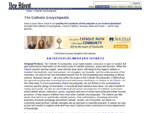 New Advent Catholic Encyclopedia New Advent Catholic Encyclopedia
More than 11,000 articles on Catholic topics, including biographies of saints, monasteries, abbeys, churches, monastic orders, monastic schools of learning, among other essential topics. Not limited strictly to ecclesiastical issues, it records all that Catholics have done, not only in behalf of charity and morals, but also for the intellectual and artistic development of mankind, chronicling what Catholic artists, educators, poets, scientists and men of action have achieved.
 Orthodox Wiki Orthodox Wiki
OrthodoxWiki is a free-content encyclopedia and information center for Orthodox Christianity that anyone can edit. The English version was started in November 2004. OrthodoxWiki is not affiliated with Wikipedia. The chief and founding administrator is Fr. John, a priest of the Orthodox Church in America (OCA). The purpose of OrthodoxWiki is to present an encyclopedia of Orthodox Christianity as represented by the mainstream Chalcedonian churches ("Eastern Orthodox").
 Wikipedia Wikipedia
Wikipedia -- from wiki (a type of collaborative website) and encyclopedia -- is a multilingual, web-based, free content encyclopedia project written collaboratively by volunteers that currently ranks among the top ten most-visited websites worldwide.The vast majority of its articles can be edited by anyone with access to the Internet. Contains several hundred useful pages on specific saints, holy sites, churches, monasteries, abbeys, among others, which are most useful to this website.
Print Resources (Alphabetical by Author)
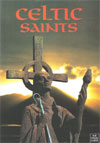 Dana Delap Dana Delap
Celtic Saints
Andover, Hampshire: Pikin Guides, n.d.
This small pamphlet traces the Celtic Saints from Ireland to Northumbria, Whitby, Wales, and Europe. It traces the origins of Celtic Christianity and has a chapters on the monastic vocation and the Celtic inheritance. Included is a useful list of the major saints and a map showing the locations of Celtic Christian sites.
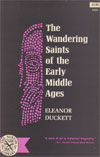 Eleanor Shipley Duckett Eleanor Shipley Duckett
The Wandering Saints of the Early Middle Ages
New York: Norton, 1964
An excellent book on the wayfaring Celtic Saints in Ireland, Scotland, Wales, England, and Brittany in the 5th, 6th, and 7th centuries, including chapters on Celtic missionaries in the 6th, 7th, 8th, and 9th centuries to Switzerland, Italy, France, Belgium, the Netherlands, Germany, Denmark, and Sweden.
 David Hugh Farmer David Hugh Farmer
The Oxford Dictionary of Saints
New York: Oxford University Press, 2005 ed.
More than 1,300 saints are profiled in this most readable, extensive, and indispensable reference work. Farmer's compilation of saints includes all English saints, all saints of whom there is or was a notable cult, and well-known and lesser-known saints from Ireland, Scotland, Wales, and the rest of Europe.
A most useful appendix of the principal patronages of saints, plus an index of the main iconographical emblems of saints, another of places, and a calendar of feast days is included.
 Britain's Pilgrim Places Britain's Pilgrim Places
London: Lifestyle Press Ltd., 2000
Britain's Pilgrim Places captures the spirit of 2,000 years of history and heritage. It covers 500 holy places and 48 major pilgrimage routes throughout England, Scotland, and Wales. A very valuable resource from the British Pilgrimage Trust.
 Martin and Nigel Palmer Martin and Nigel Palmer
The Spiritual Traveler - England, Scotland, and Wales:
 The Guide to Sacred Sites and Pilgrim Routes in Britain The Guide to Sacred Sites and Pilgrim Routes in Britain
Mahwah, New Jersey: HiddenSpring, 2000
While other books have toured British monasteries and churches, the Palmers go one step further by exploring the entire sacred landscape: holy wells, sacred cities, and plant and animal life, and includes detailed descriptions of cathedrals, pilgrim roads, henges, druids' circles, shrines, monasteries, ruins, graveyards and martyrdom sites. Unfortunately, the book is marred by the author's constant and annoying editorializing.
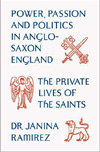 Dr. Janina Ramirez Dr. Janina Ramirez
The Private Lives of Saints: Power, Passion and Politics in Anglo-Saxon England
London: WH Allen, 2015
This book explores the real lives of over a dozen seminal saints -- among them Columba, Cuthbert, Hilda, Wilfrid, and Bede -- re-evaluating their lives, their desire for adulation, power, wealth, and legacy, through the art and literature that inspired them, the landscapes and buildings that inspired them, the issues that preoccupied them, and the symbolic world that mattered most to them.
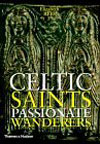 Elizabeth Rees Elizabeth Rees
Celtic Saints: Passionate Wanderers
NY: Thames & Hudson, 2000
Using archaeological and literary evidence, Elizabeth Rees presents the fascinating stories of some of the best known Celtic saints--St. Patrick and St. Bridget in Ireland, St. David in Wales, St. Columba in Scotland, and St. Aidan and St. Cuthbert in Northumbria--as well as lesser-known monks, nuns, missionaries, and martyrs. From St. Michael's Mount in the south to Iona and Lindisfarne in the north, the author takes us on a spiritual tour of the sacred places where the saints chose to pray, preach, and study.
 Shirley Toulson Shirley Toulson
Celtic Journeys: In Scotland and the North of England
Glasgow: Fount, 1995
Outwardly this looks like a tour book. Inside, it is really an accounting -- with detailed instructions given so visitors can find locales -- of early Christian saints who traveled around these areas. It gives a telling account of the inevitable conflict between the Celtic Church and the Roman Church, yielding insight into the Celtic character and how it seemed to have melded with the early Church in those regions, to produce such a Celtic-based religious atmosphere.
Other Resources: DVDs
How the Celts Saved Britain
DVD
 Travelling back in time to some of the remotest corners of the British Isles, Dan Snow, Presenter, unravels the mystery of the lost years of 400-800 A.D., when the collapse of the Roman Empire left Britain in tatters. In the first episode, A New Civilization, Snow shows how in the 5th century A.D., Roman 'Britannia' was plunged into chaos by the arrival of Anglo-Saxon invaders. As Roman civilisation disappeared from Britain, a new civilisation emerged in one of the most unlikely places - Ireland. Within a few generations, Christianity transformed a backward, barbarian country into the cultural powerhouse of early medieval Europe. In the second episode, Snow follows in the footsteps of Ireland's earliest missionaries as they venture through treacherous barbarian territory to bring literacy and technology to the future nations of Scotland and England. Originally broadcast on BBC in 2009. Travelling back in time to some of the remotest corners of the British Isles, Dan Snow, Presenter, unravels the mystery of the lost years of 400-800 A.D., when the collapse of the Roman Empire left Britain in tatters. In the first episode, A New Civilization, Snow shows how in the 5th century A.D., Roman 'Britannia' was plunged into chaos by the arrival of Anglo-Saxon invaders. As Roman civilisation disappeared from Britain, a new civilisation emerged in one of the most unlikely places - Ireland. Within a few generations, Christianity transformed a backward, barbarian country into the cultural powerhouse of early medieval Europe. In the second episode, Snow follows in the footsteps of Ireland's earliest missionaries as they venture through treacherous barbarian territory to bring literacy and technology to the future nations of Scotland and England. Originally broadcast on BBC in 2009.
Other Resources: Audio
 The Celts: What Were the Celts in Britain Really Like? The Celts: What Were the Celts in Britain Really Like?
BBC 4 Radio: In Our Time, February 21, 2002
Around 400 BC a great swathe of Western Europe from Ireland to Southern Russia was dominated by one civilisation. Perched on the North Western fringe of this vast Iron Age culture were the British who shared many of the religious, artistic and social customs of their European neighbours. These customs were Celtic and this civilisation was the Celts. What were the Celts in Britain really like?
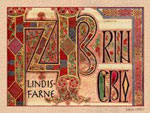 The Lindisfarne Gospels: Unifying Christianity in Britain The Lindisfarne Gospels: Unifying Christianity in Britain
BBC 4 Radio: In Our Time, February 20, 2003
In 597 Pope Gregory the Great ordered that a mission of monks be sent from Rome to convert Britain to its own brand of Christianity - lest it be submerged by the pagan beliefs of the Anglo-Saxon overlords. Just over 100 years later, the Lindisfarne Gospels were produced - lavish and ornate manuscripts, central to the story of how Britain came to be unified by the flag of the Roman Church – and they came to embody a set of beliefs and ideas that dominated Britain for a thousand years.
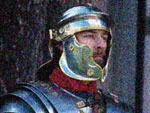 Roman Britain: The Effects of 400 Years of Occupation Roman Britain: The Effects of 400 Years of Occupation
BBC 4 Radio: In Our Time, May 1, 2003
About 2000 years ago, Tacitus noted that “the climate is wretched”, Herodian said, “the atmosphere in the country is always gloomy”, Dio said “they live in tents unclothed and unshod, and share their women” and the historian Strabo said on no account should the Romans make it part of the Empire because it will never pay its way. But invade they did, and Britain became part of the Roman Empire for almost four hundred years. But what brought Romans to Britain and what made them stay?
 St Hilda: The Life and Times of the Abbess of Whitby St Hilda: The Life and Times of the Abbess of Whitby
BBC 4 Radio: In Our Time, April 5, 2007
The 7th century saint, Hilda, or Hild as she would have been known then, wielded great religious and political influence in a volatile era. The monasteries she led in the north of England were known for their literacy and learning and produced great future leaders, including 5 bishops. The remains of a later abbey still stand in Whitby on the site of the powerful monastery she headed there.
 The Venerable Bede: The Father of English History The Venerable Bede: The Father of English History
BBC 4 Radio: In Our Time, November 25, 2004
In 731 AD, in the most far-flung corner of the known universe, a book was written that represented a height of scholarship and erudition that was not to be equalled for centuries to come. It was called the Ecclesiastical History of the Angle Peoples and its author was Bede. A long way from Rome, in a monastery at Jarrow in the North East of England, his works cast a light across the whole of Western Civilisation and Bede became a bestseller, an internationally renowned scholar and eventually a saint.
|